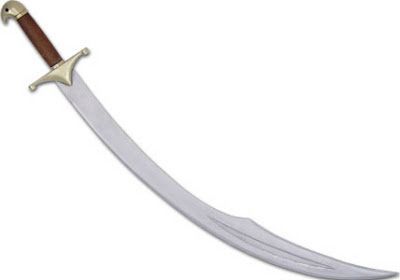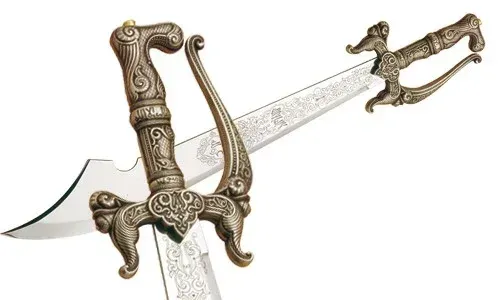What is a Falchion?
The alfanje is an iconic sword that arises from the cultural fusion of the Iberian Peninsula, serving as a testament to the exchange of knowledge between Muslim and Christian civilizations. Its name, derived from the Hispano-Arabic "al-janyar," meaning "the dagger," reflects its roots in Muslim culture and its use as a combat tool throughout past centuries.
Origin and Etymology
The term "alfanje" has deep roots in the linguistic and cultural history of the Iberian Peninsula. Derived from Hispano-Arabic, this word is evidence of the contact between Islamic and European cultures. Alfanjes were widely employed from the Middle Ages to the Renaissance, with their use spreading across the Mediterranean and particularly in Italy.

Characteristics of the Alfanje
-
- Wide and Curved Blade: This is one of the most distinctive features of the alfanje. This characteristic not only gives it a majestic appearance but also optimizes its use for effective cuts. Its structure is ideal for delivering decisive slashes, making this sword a preferred weapon in armed combat.
- Edges: The alfanje typically has a single-edged blade, but in some designs, the back edge extends into its last third, allowing for additional versatility in handling.
- Historical Use: Throughout its extensive history, the alfanje has been a constant ally in battle for warriors from various cultures. During the time of the Muslim conquest, it was introduced to the Iberian Peninsula, where it quickly adapted to new tactics and wartime needs.
- Regional Variations: Although primarily recognized as a combat weapon, in certain regions of Mexico, the term "alfanje" is still used to describe an agricultural tool meant for cutting weeds, demonstrating its semantic longevity and adaptability.
Comparison with Other Weapons
The alfanje is often compared to the European falchion, a sword that is also curved but comes from a different heritage. While the falchion has its roots in seax and scramasax weapons, the alfanje reflects a design with greater Eastern influence. This distinction underscores the cultural richness and diversity of influences that characterize each of these weapons.
Importance in the Iberian Peninsula
During the Muslim conquest of the Iberian Peninsula, the alfanje was introduced by the Moors, who brought with them a vast collection of weapons and combat techniques. The alfanje, in particular, was quickly absorbed by Christian warriors, who appreciated its effectiveness in close combat.

Cultural References
Throughout history, the alfanje has appeared in various literary and artistic works, prominently featured in Renaissance poetry. Examples include poetic verses that honor and evaluate its unique design, celebrating both its utility and the complexity of its craftsmanship. Phrases such as "I didn't mean to say alfanje, / because if I named it alfanje / without mentioning the Damascus, / the alfanjes would be angered" illustrate its prestigious position in Renaissance literature.
Cultural and Technical Impact
The history of the alfanje is both a narrative of military technology and a living cultural story. Its evolution and adaptability reflect not only the pragmatic need of societies to defend themselves but also their capacity to integrate and refine foreign influences into something unique and powerful.
There is a world of meanings and uses behind every defined arc that the alfanje presents. This weapon is not merely a war artifact but a legacy of human interaction and its constant adaptations to new times and cultures.
















